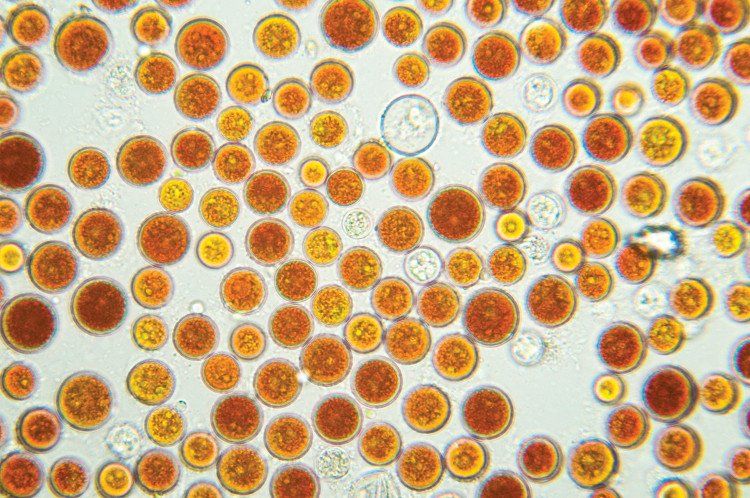Microalgae ingredient landscape growing increasingly diverse: SupplySide East report
From astaxanthin and phytoplankton to a brand new vegan vitamin D3 source, microalgae innovation is prolific in the nutrition space.
Photo © iStockphoto.com/peepo

Microalgae is not new to the natural products industry, with ingredients such as astaxanthin, spirulina, and chlorella well established, but it’s a segment in which innovation continues at a quick pace. At this year’s SupplySide East trade show in Secaucus, NJ, microalgae ingredients, old and new, were on display.
Lonza (Morristown, NJ) made its microalgae debut with Oceanix, a marine phytoplankton ingredient sourced from-you guessed it-the ocean. “Oceanix is the latest in our active-performance portfolio,” explained Cliff Barone, senior manager, global marketing, consumer health and nutrition, for Lonza. “What we’ve seen in the sports performance arena is that it’s really catering to active performance, so going beyond those core hardcore athletes and body builders, and going more mainstream. This ingredient is really for that mainstream, active enthusiast.”
The mainstream active-nutrition enthusiast includes, in large part, Millennials, who are seeking some specific benefits. “With Millennials, in particular, we know that over 80% of sports nutrition users are after energy, and they want support for performance as well as recovery.”
Oceanix is vegan, non-GMO, and sustainably manufactured, hitting a lot of the marks that clean-label manufacturers and consumers alike look for. In terms of efficacy, Oceanix has shown good results in an open-label human pilot study, the company said. Not yet published, the study included young soccer players in their late teens who were given 25 mg of Oceanix per day for 30 days. Results showed that supplementation improved performance by significantly decreasing heart rate during exercise and significantly increasing hemoglobin levels. Subjects also saw a significant decrease in body fat mass and saw better recovery after exercise and significantly increased vitamin E levels, suggesting a reduction in oxidative stress.
When it comes to formulation, Oceanix is convenient to work with because it is very concentrated and requires a very small dose, Lonza said. “The dose size is so small that it provides flexibility,” said Barone. “We can see it being added into pre-workout powder formulations, post-workouts, those types of things. It’s not water soluble, but it’s a small dose so it will disperse and not impact flavor or organoleptics.”
Another new microalgae ingredient is VegD3, a vegan vitamin D3 distributed by AIDP (City of Industry, CA). This is an important ingredient because there are very few vegan sources of vitamin D3. For example, the main source of vitamin D3 is lanolin, an oil from sheep’s wool and therefore not vegan. Until now, lichen has been the only other vegan source of vitamin D3. (Other plant-based ingredient sources provide vitamin D2, which is poorly absorbed.) Now, however, vitamin D3 from microalgae provides more options and a sustainable source of the nutrient, meeting consumer demand.
“In the U.S., we have more and more people looking for plant-based alternatives. And, if you take a country like India”-from which AIDP’s partner for this ingredient, Avlaan Inc., operates-“which has such a large population of vegans, and, in certain cases, the Jain community, which has restrictive dietary practices, this is ideal for them,” explained Mark Thurston, CEO of AIDP, to Nutritional Outlook. “It’s fat soluble. We can emulsify it, as well, so it can go into water-based applications. The Organic & Natural Health Association, of which we are members, has been pushing the benefits of D3 for years, because it’s very important that mothers and babies get adequate D3. For communities which are not meat eaters, that has been a major problem. Even with soy formulas, up until now, they’ve either not been putting D3 in their products at all or have been using D2 from plant sources.”
Photo © iStockphoto.com/Nancy Nehring

Astaxanthin Thriving
The key to astaxanthin’s success may be that its benefits are actually felt by its users. Karen Hecht, PhD, scientific affairs manager for AstaReal Inc. (Burlington, NJ), says that her company is focusing on some key areas in which users can “really feel the difference when it comes to returning to an ingredient and understanding why it’s good for you.” Currently, she said, those areas include muscle function and eye health. And then there is also skin health. “The difference that you can see in skin health-I mean, it almost sells itself for skin health,” she said. “People want natural ingredients for the skin, and they want something that they can take orally. The beauty-from-within concept is pretty well established at this point” for astaxanthin.
While lutein has commanded most of the spotlight for eye health when it comes to blue light solutions, the blue light category presents a lot of opportunity for astaxanthin to play in as well. Astaxanthin can help to create a more holistic approach to combatting blue light damage and eye fatigue incurred by digital device use, etc. “It’s all interconnected,” said Hecht. “It’s the blue light hitting the retina-that’s what lutein and zeaxanthin are for-and then it’s the muscles working hard at the front of the eye, because the near focus is getting tired, and the that’s where astaxanthin works, at the front of the eye. It’s those two aspects, plus the reduced blinking time, which contribute to dry eye. All those things are [implicated in] digital device use [and blue light damage].”
Innovation into other astaxanthin delivery formats is also creating more engagement with astaxanthin consumers, including AstaReal’s new gummy supplements. “I think awareness is creeping up. What I see happening is people getting excited about things that aren’t softgels. Suddenly, now that we’ve been featuring these gummies, it seems like people are opening up to not just an ingredient, but a new delivery system which seems to be a little bit more friendly,” said Hecht. “Astaxanthin can fit into a drink, a drink mix, a serum, a chew, or a gummy.”
One common complaint about gummies is that they contain lower active-ingredient doses than their pill counterparts. However, AstaReal’s astaxanthin gummies have a dose of 4 mg, the level that allows companies to make several claims. “[A dose of] 4 mg is where you start to really get a lot of flexibility already,” she explained. “When we’re talking about 2 mg or 3 mg, [the claims are] pretty much just for skin. At 4 mg, you’re adding muscle endurance and recovery, and you’re adding focus for eye function.”
Prinova acquires Aplinova to further increase its footprint in Latin America
April 7th 2025Prinova has recently announced the acquisition of Brazilian ingredients distributor Aplinova, which is a provider of specialty ingredients for a range of market segments that include food, beverage, supplements, and personal care.










